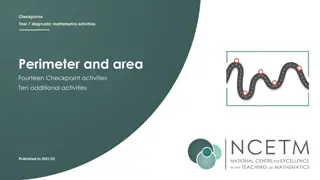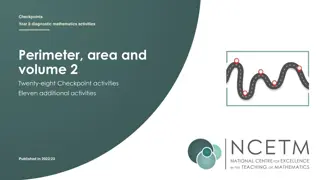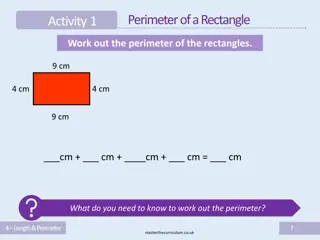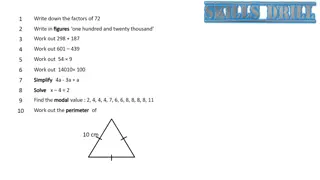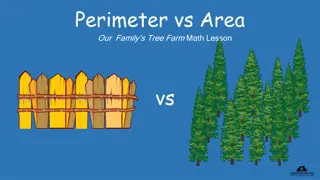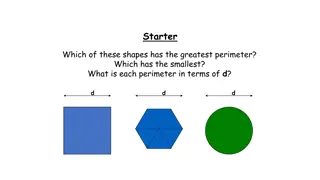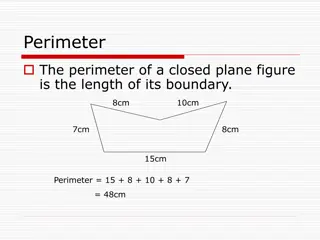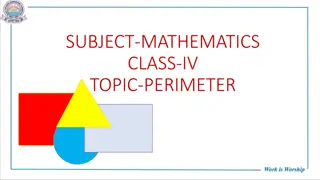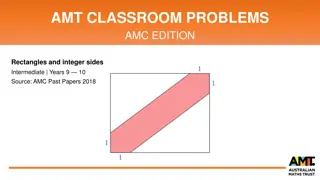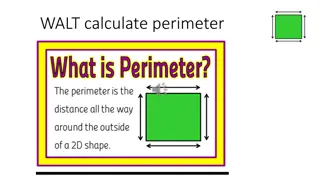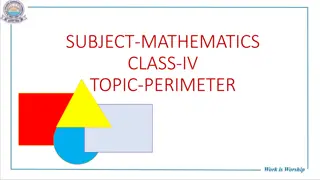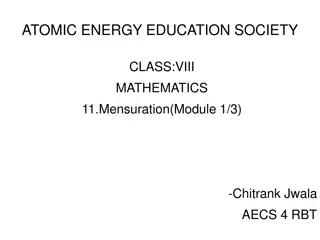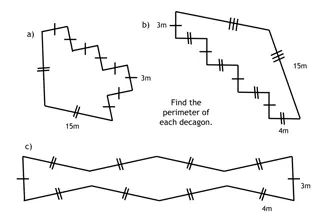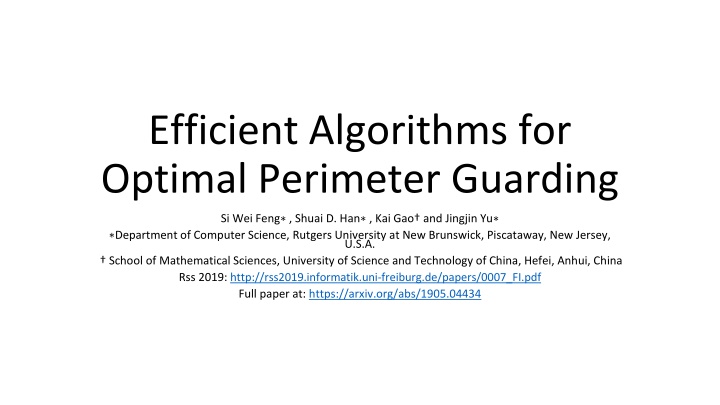
Efficient Algorithms for Optimal Perimeter Guarding - Problem Description and Examples
Explore the optimal perimeter guarding (OPG) problem, focusing on finding the best partition to minimize the maximal region a robot has to guard. Understand basic notations, perimeters containing single components, and improvements in algorithm efficiency.
Download Presentation

Please find below an Image/Link to download the presentation.
The content on the website is provided AS IS for your information and personal use only. It may not be sold, licensed, or shared on other websites without obtaining consent from the author. If you encounter any issues during the download, it is possible that the publisher has removed the file from their server.
You are allowed to download the files provided on this website for personal or commercial use, subject to the condition that they are used lawfully. All files are the property of their respective owners.
The content on the website is provided AS IS for your information and personal use only. It may not be sold, licensed, or shared on other websites without obtaining consent from the author.
E N D
Presentation Transcript
Efficient Algorithms for Optimal Perimeter Guarding Si Wei Feng , Shuai D. Han , Kai Gao and Jingjin Yu Department of Computer Science, Rutgers University at New Brunswick, Piscataway, New Jersey, U.S.A. School of Mathematical Sciences, University of Science and Technology of China, Hefei, Anhui, China Rss 2019: http://rss2019.informatik.uni-freiburg.de/papers/0007_FI.pdf Full paper at: https://arxiv.org/abs/1905.04434
Problem description and examples The optimal Perimeter Guarding (OPG) problem is to find the best partition to regions s.t. the maximal region a robot needs to guard is minimized.
Basic notations ? - number of robots ? - number of regions ??- number of connected components in region ?
Notations ? regions ? = ?1, ,?? ???is ??boundary ??? ?1 ?? = ??1, ,??? ?? ???is called the perimeter of ?? ??is the part covered by robot ? in a given cover ? is the maximal length of any ??in an optimal cover
Optimal Perimeter Guarding (OPG) Given the perimeter .
Perimeters Containing Single Components
Perimeters Containing Single Components In a potential optimal solution: For a given region ??, each of the ??robots assigned to guard it must each guard a length ??= ???(??)/?? For (at least) one region ??, it holds that ??= ? (the maximal single robot coverage length) Thus, one can try for each ??all possible 1 ?? ? and find the minimum ??= ???(??)/??that is feasible. Such ??and ??will be named ?? ? will be the smallest among all computed ?? ?and ?? ?respectively. ?.
Improvements ?the minimum Can use binary search over 1 ?? ? to find ?? ???(??)/??that is feasible for a given region ?? If we start by first examining the longest ??, only up to one candidate ?? produce a better result (? ). ?per any remaining region ??has the potential to
Examining the longest ??first Assume ?1is the longest perimeter Not feasible Doesn t improve result over ?1 ?
Perimeters Containing Single Components Running time: ?(? log ? + log ? )
Single Perimeter Containing Multiple Components
Single Perimeter Containing Multiple Components We Know how to cover multiple regions without gaps, why not think of every connected component as a single region without gaps?
Lemma No gap needs to be partially covered by a robot For a perimeter ?, there exists an optimal cover ? = ?1 ?? , ,?? ? = ? ?? ?? such that, for any gap ? and any ? = ? , ??
Notations 2.0 Let a perimeter ? have ? segments ?1, ,?? which are divided by ? gaps {?1, ,??} Example: A region with five segments ?1, ,?5and five gaps ?1, ,?5
Proposition 3 - There are OPG instances in which the biggest gap must be covered. The optimal cover with ? = 3 is to have ? = {?1,?2,(?3 ?3 ?4)} In ? we have ? = ???(?1) Red cover: l = ??? ?1 Blue cover: ? 3??? ?1+0.5??? ?1 blue cover is worse 3 ??? ?3 = 1.5???(?1)
Single Perimeter Containing Multiple Components A baseline algorithm: For all 1 ?,? ? denote the part of ?? from ??to ?? following a clockwise direction and including the gaps as Skk len Skk nkk the biggest ??? s.t. the len Skk nkk Theorem 5 states that for some 1 ?,? ?, = l c c To find ? , for each 1 ?,? ? we find nkk problem is feasible and compute lkk c = c c is ? The smallest lkk Running time O(?2 ?) O(feasibility check)
feasibility check For checking feasibility of a particular ??? i.e., whether ??? is long enough for the rest of the robots to cover the rest of the perimeter we simply tile ? ??? copies of ??? over the rest of the perimeter. Thus time complexity is O ?2 ? O(q) = O(?3 ?)
Variants and results multiple perimeters with each having a single connected component ?(? log ? + log ? ) ?(? log ? + log ? ) multiple perimeters with each having a single connected component single perimeter containing multiple connected components ?(?2log ? + ? ) ?(?2log ? + ? ) single perimeter containing multiple connected components multiple perimeters with each containing multiple connected components ? 1 ? ??? ? 1 ? ??? multiple perimeters with each containing multiple connected components 2log ? + 1 ? ??? 2log ? + 1 ? ???

